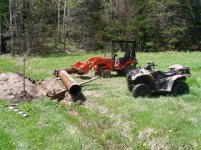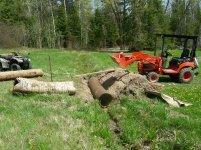wawajake
Veteran Member
Had some fun last week removing 15ft of 12 inch culvert plugged with clay because previous owner installed it in two pieces and over time it filled up.
Luckily the small one came out after using middle buster to open trench and FEL to expose . And then a chain and sling to walk it out from each end. But the remaining 10 ft piece weighed far to much. But with some coaxing and using my BX2660 and my ATV , I was able to work the big piece out too. A few times the tractors wanted to tip , but from lessons learned on this site (like always keep hand on FEL hydraulics) was able to drop quickly when got hairy and get a better grip and try again.
Yes I should not of stopped to take a picture at the precarious moment , but some here like pics !!!!.
Anyway a clean 15inch 10 ft used culvet went back in and the old one I rollled into bush and buried with the dirt I got from the same ditches in pics that I cleaned better with FEL after .
Was a fun 6 hrs of seat time (including ditch/swale cleaning)
jake
Luckily the small one came out after using middle buster to open trench and FEL to expose . And then a chain and sling to walk it out from each end. But the remaining 10 ft piece weighed far to much. But with some coaxing and using my BX2660 and my ATV , I was able to work the big piece out too. A few times the tractors wanted to tip , but from lessons learned on this site (like always keep hand on FEL hydraulics) was able to drop quickly when got hairy and get a better grip and try again.
Yes I should not of stopped to take a picture at the precarious moment , but some here like pics !!!!.
Anyway a clean 15inch 10 ft used culvet went back in and the old one I rollled into bush and buried with the dirt I got from the same ditches in pics that I cleaned better with FEL after .
Was a fun 6 hrs of seat time (including ditch/swale cleaning)
jake




